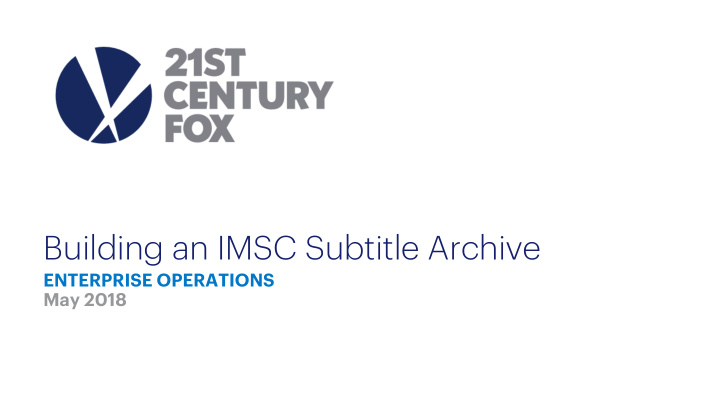



Building an IMSC Subtitle Archive Operationalizing IMF at Fox ENTERPRISE OPERATIONS May 2018
Building a Subtitle Archive Problems we’ve had with our archive • Inconsistency • Interoperability problems • Constant re-manufacturing
Building a Subtitle Archive We can all relate to these types of issues • Poor sync • Subtitles covering text • Subtitles over matte • Unreadable text • Bad font choices
Building a Subtitle Archive But Dave? How can we fix this?
Building a Subtitle Archive Understand and control your end to end workflow • Does your workflow begin with a stylized archive, or distribution? • How many vendors author your subtitles? • What tools will be used to create the subtitles? • What tools will be used to transform the subtitles? • Where will these be delivered? • What compromises are you willing to accept?
Subtitle Workflow Our end to end workflow • We are constantly learning from our failures • We want to create once, repurpose many • Archive • Stylized burn-in source • Distribution • HDR/SDR • We work with numerous subtitle vendors • Subtitle style guide • Strict IMSC 1.0 specification • Involved technical onboarding process • Our subtitles potentially go through various transformation or transcoding tools • We’ve made compromises with our subtitle style and font style choices due to platform and device decoding inconsistencies
Subtitle Workflow Streaming platforms have changed our approach • Component localization has raised the bar for subtitles • Much tighter timing tolerances are expected • Higher quality transcriptions/translations are expected • Component localization has lowered the bar for subtitles • Stylized subtitles are not required • Subtitle placement is simplified • Font size is variable based on playback device • Certain IMSC 1.0 attributes are ignored or overwritten
Subtitle Workflow Platform decoding behaviors • Placement can change • Visual style can change • Font sizes can change
Subtitle Comprimises How have we addressed these discrepancies? • Our subtitle style is written so that platform modifications are minimized • Our default placement is bottom center • We add character identifiers to indicate the speaker when needed • We still include an explicit visual style into our subtitles for consistency • Source for image based subtitles • Helps with QC on a mastering tool • Burning into picture is easy • Downstream platforms will eventually decode as described (hopefully!)
IMSC 1.0 How has IMSC 1.0 helped our workflows? • Standardized file format for long-term archive • Direct pass-through into our IMF Packages • Direct delivery to our customers • Timing issues with fractional frame rates can be minimized • Complex font styles can be natively described
IMSC 1.0 Specification We have standardized certain attributes – Time Expression • Fractional frame rates are hard (sorry about that) • 23.976fps is SLOWER than real-time • The typical media timebase syntax options are HH:MM:SS:FF, HH:MM:SS.ms, or frames • Here’s the math for a 23.976fps time code value of 01:00:00:00: HH:MM:SS:FF 01:00 00:0 :00:00 0:00 = = 86400 frames 86400 / (24000/1001) = 3603.6s 3603.6 = 01:00: 00:03:14 03:14 IMSC 1.0 XML Example: <p begin= "01:00:03:14" ...
IMSC 1.0 Specification We have standardized certain attributes – Time Expression • Fractional frame rates are hard (sorry about that) • 23.976fps is SLOWER than real-time • The typical media timebase syntax options are HH:MM:SS:FF, HH:MM:SS.ms, or frames • Here’s the math for a 23.976fps time code value of 01:00:00:00: HH:MM:SS.ms 01:00 00:0 :00:00 0:00 = = 86400 frames 86400 / (24000/1001) = 3603.6s 3603.6 = 01:00: 00:03 03.5 .583 83 IMSC 1.0 XML Example: <p begin= "01:00:03.583" ...
IMSC 1.0 Specification We have standardized certain attributes – Time Expression • Fractional frame rates are hard (sorry about that) • 23.976fps is SLOWER than real-time • The typical media timebase syntax options are HH:MM:SS:FF, HH:MM:SS.ms, or frames • Here’s the math for a 23.976fps time code value of 01:00:00:00: frames 01:00 00:0 :00:00 0:00 = = 86400 frames IMSC 1.0 XML Example: <p begin= "86400f" ...
IMSC 1.0 Specification We have standardized certain attributes – Font Stylization • fontFamily="" • backgroundColor="black" • color="white" • textOutline="" Arms back, chest out, fanny in. Lift, lift!
IMSC 1.0 Specification We have standardized certain attributes – Font Stylization • fontFamily="proportionalSansSerif" • backgroundColor="black" • color="white" • textOutline="" Arms back, chest out, fanny in. Lift, lift!
IMSC 1.0 Specification We have standardized certain attributes – Font Stylization • fontFamily="proportionalSansSerif" • backgroundColor="transparent" • color="white" • textOutline="" Arms back, chest out, fanny in. Lift, lift!
IMSC 1.0 Specification We have standardized certain attributes – Font Stylization • fontFamily="proportionalSansSerif" • backgroundColor="transparent" • color="#DCDCDC" • textOutline="" Arms back, chest out, fanny in. Lift, lift!
IMSC 1.0 Specification We have standardized certain attributes – Font Stylization • fontFamily="proportionalSansSerif" • backgroundColor="transparent" • color="#DCDCDC" • textOutline="black 4%"
IMSC 1.0 & HDR Yes, it does actually work (with some effort) • IMSC 1.0 has no separate luminance control. IMSC 1.1 adds this functionality • Platforms must be educated on proper text based subtitle compositing • Platforms have creative control over luminance level in their ecosystem
0 Nits 100 Nits IMSC 1.0 & HDR ↑
0 Nits 100 Nits 1,000 Nits 10,000 Nits IMSC 1.0 & HDR ↑ Yep, that was a good one.
0 Nits 100 Nits 1,000 Nits 10,000 Nits IMSC 1.0 & HDR ↑
Summary Have a clear strategy • Author once for archive and distribution needs • Document and distribute clear specifications • Work your distribution partners to ensure they can work with your assets • Understand the end to end workflow, and control what you can
Questions?
Recommend
More recommend